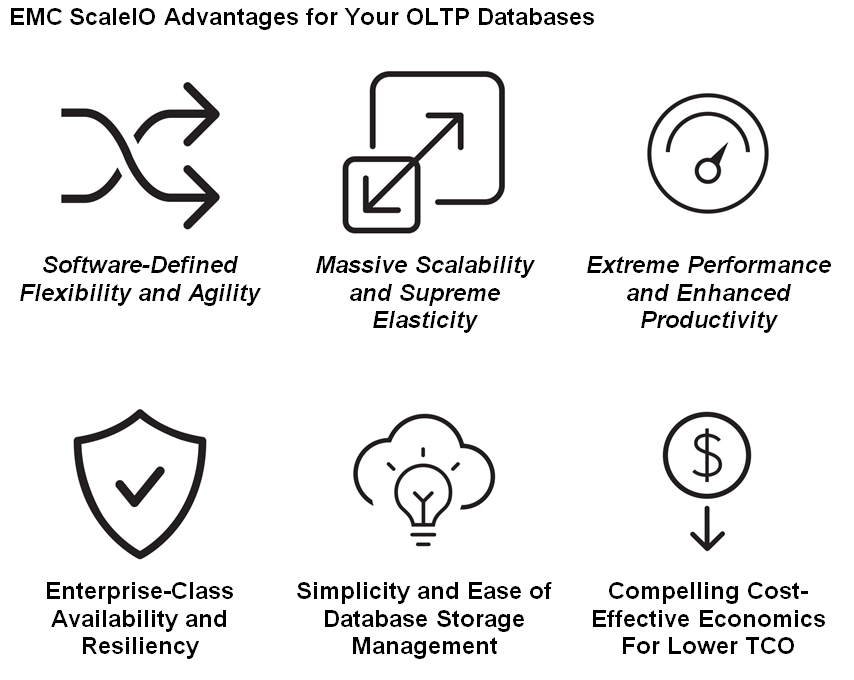When it comes to getting the best from today’s enterprise OLTP databases, a powerful storage solution is vital. Let’s explore how EMC ScaleIO software-defined block storage gives DBAs all the performance, scalability and resiliency they demand – while also giving infrastructure managers the flexibility, ease of management and cost-efficiency they need.
You may be running traditional enterprise OLTP (on-line transaction processing) database applications from vendors like Microsoft, Oracle and SAP. Perhaps you’re exploring new in-memory databases like SAP HANA, or the latest scale-out databases based on NoSQL (including Cassandra, MongoDB, CouchDB, Apache HBase and so on).
When it comes to database storage, you may be using a high-performance purpose-built array to make it all work. Or, if you have economies-of-scale issues, that may drive you to building your own system with direct-attached storage (DAS).
But software-defined storage (SDS) now offers a third option that promises the best of both worlds. EMC ScaleIO uses smart software to connect multiple industry-standard x86 servers into a shareable pool of high-performance block storage – creating a server-based virtual SAN. Our customers are increasingly embracing ScaleIO as a next-generation block storage platform for their databases – and here are some great reasons why…
Software-Defined Flexibility and Agility
ScaleIO software is agnostic to hardware and hypervisor, running on the x86 server infrastructure most organizations already use. ScaleIO can also be deployed flexibly – in a ‘storage-only’ model where storage and applications are on physically separate servers, or in a ‘hyper-converged’ model where each server hosts both applications and shared storage. ScaleIO’s tiny resource footprint means that running hyper-converged has minimal impact on database performance, making this an increasingly popular option.
With software-defined storage, database servers can easily tap into a flexible pool of storage, on-demand. But many organizations are also looking to offer internal customers database services in a cloud computing model. I’ve been very happy to hear that a number of EMC customers are now using ScaleIO to provide ‘databases-as-a-service’ (DBaaS) to their internal customers.
Massive Scalability and Supreme Elasticity
Modern database architectures are built for scale. However, in a traditional DAS environment, what if you want to add more storage – but have no free drive bays or PCIe slots remaining on your database server?
A key attraction of software-defined storage for database admins is freedom from these capacity restrictions. With ScaleIO, you can discover simple scalability to multi-petabyte capacity. A ScaleIO cluster can add storage devices and servers on the fly to increase capacity – from a handful of server nodes to over a thousand. With ScaleIO, your storage growth is always automatically aligned with your database application needs.
Extreme Performance and Enhanced Productivity
All this flexibility and scalability would be less attractive to DBAs if it meant experiencing sub-optimum OLTP performance. But don’t worry – with ScaleIO, you’ll enjoy equivalent or better performance when compared to high performance direct-attached storage.
As your ScaleIO system grows, performance scales linearly to deliver tens of millions of IOPS. ScaleIO delivers all the IOPS to meet your enterprise database demands. When rebuilds and rebalances are needed, performance optimization and tiering is automatic, resulting in no impact to critical database workloads and SLAs.
Enterprise-Class Availability and Resiliency
Modern OLTP database environments are increasingly mission-critical and require 99.999% availability. ScaleIO’s infrastructure resiliency means you can usually avoid the necessity for node removal for simple disk failures. However, if you do need to add or remove nodes from a ScaleIO cluster, this can be done with near-zero impact to downtime or application SLAs. One of our customers spoke recently at EMC World about performing upgrades midday on their ScaleIO system – not something you’d consider on a traditional production storage platform.
In another customer example, there is a major mobile telecom operator who offers a cloud backup service for its customers’ smartphone data. The operator uses Cassandra as a high-speed database application for this service. However, with the original deployment on direct-attached storage, even one node failure unacceptably diminished performance – and the system was taking up to 45 minutes to heal. To bring added resiliency and performance to their database storage, the operator deployed ScaleIO. Now a single disk failure doesn’t take the entire node down, and even a full node failure is quickly recovered – in as little as 6 minutes.
Simplicity and Ease of Database Storage Management
Unlike a traditional Fibre Channel SAN, ScaleIO storage was created to be easy to manage. A single admin can easily add or remove nodes from a cluster, and quickly deploy new clusters. As ScaleIO is software-defined storage, you can programmatically deploy your perfect database configuration in seconds – in a process that’s completely reproducible, time after time.
Large organizations may have thousands of servers running scale-out database applications – but with no central visibility into the status or performance of the tens of thousands of storage devices being utilized. With ScaleIO, you gain complete storage visibility to drive-level I/O – so you can see and proactively solve issues before they become problems.
Compelling Cost-Effective Economics For Lower TCO
ScaleIO’s ability to scale compute and storage independently drives a lower total cost of ownership (TCO). A ScaleIO system is built on standard x86 server hardware and Ethernet networking – so it cost-effectively uses the infrastructure you have to buy anyway, while transforming it into a powerful software-defined environment.
ScaleIO as a modern hyper-converged deployment can consolidate all your database applications and storage onto a single platform – avoiding storage silos, driving efficiencies, and giving visibility of storage resources across the datacenter – which all contributes to a lower TCO.
Transform Your Database Performance With ScaleIO
Interested to see what EMC ScaleIO could do for your OLTP databases? Then why not explore the advantages of software-defined block storage for yourself:
EMC ScaleIO software is available to download and try for free.
